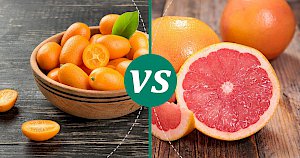Grapefruit vs Kumquats: Nutrition, Calories & Protein Compared


Grapefruit vs Kumquats
Nutrition Facts
Serving size:
change
5g10g15g20g30g40g50g60g80g100g120g140g160g180g200g220g250g300g350g400g450g500g600g700g800g900g1000g
1oz2oz3oz4oz5oz6oz7oz8oz10oz12oz15oz20oz25oz30oz35oz40oz50oz
Amount Per Serving:
Serving size:
change
5g10g15g20g30g40g50g60g80g100g120g140g160g180g200g220g250g300g350g400g450g500g600g700g800g900g1000g
1oz2oz3oz4oz5oz6oz7oz8oz10oz12oz15oz20oz25oz30oz35oz40oz50oz
Amount Per Serving:
Grapefruit vs Kumquats 100g Compare
| per 100g | Grapefruit | Kumquats |
|---|---|---|
| Calories | 42 | 71 |
| Carbohydrates | 10.66 g | 15.9 g |
| Fat | 0.14 g | 0.86 g |
| Dietary fiber | 1.6 g | 6.5 g |
| Protein | 0.77 g | 1.88 g |
| Calcium | 22 mg | 62 mg |
| Iron | 0.08 mg | 0.86 mg |
| Magnessium | 9 mg | 20 mg |
| Potassium | 135 mg | 186 mg |
| Vitaminium A | 1150 µg | 290 µg |
| Vitaminium B1 (Thiamine) | 0.043 mg | 0.037 mg |
| Vitaminium B2 (riboflavin) | 0.031 mg | 0.09 mg |
| Vitaminium B3 (Niacin) | 0.204 mg | 0.429 mg |
| Vitaminium B5 | 0.262 mg | 0.208 mg |
| Vitaminium B6 | 0.053 mg | 0.036 mg |
| Vitaminium B9 (Folic acid) | 0.013 mg | 17 mg |
| Vitaminium C | 31.2 mg | 43.9 mg |
| Vitaminium E | 0.13 mg | 0.15 mg |
| Beta karoten | 686 mg | 155 mg |
A Citrus Spotlight: Diving into the World of Grapefruit and Kumquats
When it comes to citrus fruits, oranges and lemons often steal the spotlight. However, the citrus family has far more to offer, particularly when you delve into the unique qualities of grapefruit and kumquats. Both fruits boast a rich history and a plethora of health benefits, making them worthy of exploration and comparison.
The Intriguing Origins and Uses
Grapefruit, with its bittersweet taste, is a relatively new addition to the citrus family. Believed to have originated in Barbados as a cross between a pomelo and an orange, it was named for the way its fruits cluster on the tree, resembling grapes. Grapefruit is not only enjoyed fresh but also makes its way into various culinary dishes, juices, and even skincare products due to its antioxidant properties.
Kumquats, on the other hand, are tiny, oval fruits native to China. They are unique in the citrus world because their sweet rind is edible, contrasting with the tartness of the flesh inside. Kumquats are often eaten whole, used in marmalades, or added as a tangy ingredient to salads and desserts. Their small size and sweet-sour profile make them a delightful and versatile fruit.
Comparing Nutritional Profiles
When considering grapefruit and kumquats, it's interesting to compare their nutritional content to understand how they stack up against each other. Here's a brief overview:
- Calories: Grapefruit offers a lower calorie count with 42 calories per 100 grams, compared to kumquats' 71 calories.
- Carbohydrates and Fiber: Kumquats lead with 15.9 grams of carbs and an impressive 6.5 grams of fiber, against grapefruit's 10.7 grams of carbs and 1.7 grams of fiber.
- Fats and Protein: Kumquats contain slightly more fat (0.86 grams) and protein (1.88 grams) than grapefruit.
- Vitamins and Minerals: Both fruits are rich in vitamins and minerals, but kumquats generally offer more, including higher amounts of vitamin C, calcium, and iron.
It's clear that both fruits have their unique advantages, with grapefruit being a low-calorie option and kumquats providing more fiber and micronutrients.
Health Benefits and Culinary Uses
The health benefits of these citrus fruits are as varied as their flavors. Grapefruit is renowned for its vitamin C content, aiding in immune system support, while its antioxidant properties can help fight aging. Kumquats are not only a great source of fiber but also pack a punch with essential nutrients that contribute to heart health and improved digestion.
Culinary-wise, grapefruit is a versatile ingredient that can enhance salads, seafood dishes, and cocktails with its refreshing zest. Kumquats, with their edible peel, offer a unique culinary twist, serving as a sweet-tart addition to baked goods, preserves, and even as a garnish for beverages and cocktails.
Final Thoughts
Both grapefruit and kumquats offer unique flavors, nutritional benefits, and culinary uses that make them stand out in the citrus family. Whether you're looking for a low-calorie snack with grapefruit or a fiber-rich treat with kumquats, incorporating these fruits into your diet can add a burst of flavor and a wealth of health benefits. So, why not explore the delightful tastes and textures of these citrus gems?
Grapefruit 100g
42kcalCalories source
- 91% CARBS.
- 7% PROTEIN
- 3% FAT
Kumquats 100g
71kcalCalories source
- 81% CARBS
- 10% PROTEIN
- 10% FAT
Compares of grapefruit
- Grapefruit vs Apple
- Grapefruit vs Apricot
- Grapefruit vs Avocado
- Grapefruit vs Banana
- Grapefruit vs Blackcurrants
- Grapefruit vs Melon
- see all compares of grapefruit
Compares of kumquats
Read also:
- Calories from Grapefruit
- Calories of Guava
- Calories in Jackfruit
- Jujube calories per 100g
- Kiwi protein per 100g
- How many calories does kumquats have?
- Calories in a half of loquat fruit
- Calories in whole loquat fruit
- Calories for one, two or more Loquat fruits
- Calories in handful of Loquat fruits
- How much protein in lychee?
Marcin Piotrowicz
calories-info.com creator
Healthy diet and healthy lifestyle promoter
Add comment